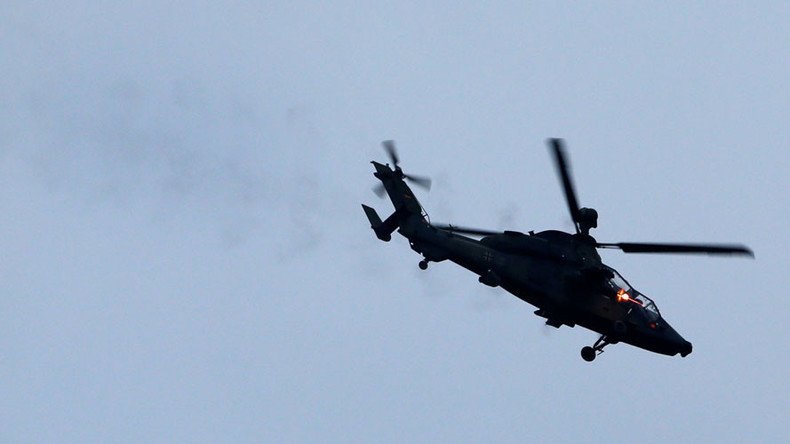‘10-second free fall’: German chopper lost rotor blades before Mali crash, probe says

A German Air Force Tiger helicopter lost its main rotor blades mid-flight when it crashed in Mali in July, a Defense Ministry report said. The crash marked another setback for the German military, which is plagued by new equipment and hardware shortages.
The attack helicopter – part of the UN-led peacekeeping mission in Mali (MINUSMA) – crashed over the Western African country on July 26, killing two pilots on board. It was the first fatal incident involving Tiger helicopters in the German Air Force, but marked another setback for the country's military.
Detailing the crash, the Defense Ministry said the aircraft began losing parts – including main rotor blades – while airborne, 10 seconds before ramming into the Mali desert, Reuters said, having seen the report.
“According to information available so far, once the vehicle had started to descend, parts of the aircraft broke off, including the main rotor blades," the ministry report said, as quoted by the news agency.
Tiger helicopter had been cruising at 250kph (155mph) at an altitude of 550 meters (1,800ft) when it “suddenly sank its nose and entered a sharp dive much to the surprise of the crew.”
The aircraft then hit the ground and caught fire, leaving no chance for both pilots, identified by Bild newspaper as Major Jan F., 33, and Captain Thomas M., 47.
Spiegel reported the Tiger was carrying full tanks and a full weapons load, which later turned the aircraft into a “fireball,” causing the ammunition to explode. Citing other excerpts from the Defense Ministry report, the outlet also said the crew had no chance to survive the crash.
Though the Bundeswehr said it does not deploy inexperienced pilots to Mali, some experts suggested that was not the case. Reinhardt Schlepphorst of the pilot lobby group IGHT told Bild that none of the Tiger pilots had accumulated the mandatory 140 flight hours required by NATO standards to be cleared for deployment, according to Deutsche Welle.
"Tiger"-Unglück in Mali: Hubschrauber-Absturz "war nicht zu überleben" https://t.co/Ud6XbFLDpNpic.twitter.com/TssLe8u9mA
— SPIEGEL ONLINE (@SPIEGELONLINE) August 9, 2017
"Our Tiger pilots don't have enough experience in the machines deployed, to fully command those helicopters in borderline situations," he said.
German Defense Minister Ursula von der Leyen dismissed speculation on Wednesday, telling the Passauer Neue Presse newspaper that there were no indications that the crash had anything "to do with the training of the pilots."
It’s unclear what caused the rotor to come off the helicopter, German Defense Ministry spokesman Jens Flosdorff told journalists on Wednesday, adding that it would take months for investigators to establish the reasons for the crash.
Flosdorff added that both parts of the helicopter’s flight data and cockpit voice recorders had been retrieved, but only one could be analyzed, Reuters reported.
Tiger helicopter manufacturer Airbus said that the company management was “aware of the interim report and are committed to support the investigation as and when required by the authorities – in the meantime, we will not comment further.”
In mid-April, it emerged that half of the German armored vehicles dispatched to the MINUSMA operation have been forced out of action because of heat, dust and irregular terrain.
Designed for the European theater, the vehicles were apparently not suitable for driving in “dust” and along “rocky roads,” Die Welt reported, citing military sources.
The newspaper also reported that the Tigers stationed in Mali were grounded for some time as they lacked permission to operate at extreme temperatures exceeding 43C (109F), while the average daytime temperature in the area exceeds 44-45C.
Other media reports suggested the German military, which operates some 27 Tiger helicopters, is experiencing “serious problems” relating to its aircraft inventory.
The Bundeswehr’s C-160 Transall airlifters are ageing, while the Airbus-made A-400M aircraft experience technical malfunctions, according to an internal Defense Ministry memo leaked to Die Welt.
Malfunctioning equipment is a pressing issue not only for the German contingent in Mali, but for the whole of the country’s military.
The head of the German Armed Forces Association (DBwV), Andre Wuestner, told the Rheinische Post in February that the Bundeswehr lacks “everything” from combat-ready helicopters and aircraft to night vision equipment.
READ MORE: Only 1 of Germany’s 8 Airbus A400M military planes ready for use – air force
Almost half of the 225 battle tanks in the German army are worn out and urgently need modernization, the Augsburger Allegmaine newspaper reported in January.
Only 38 out of Germany’s 89 Tornado fighter jets are combat ready and only 25 out of 57 transport airplanes are operational, according to a report by Deutsche Welle.
Strike helicopters, personal carriers and sea vessels are also in poor condition, with just 30 percent or less being deployable, the broadcaster added.
Last year, Inspector of the Army, Lieutenant General Joerg Vollmer, warned that the German military’s information exchange with its NATO allies may also be at risk due to the long-outdated communication devices used by the Bundeswehr.














